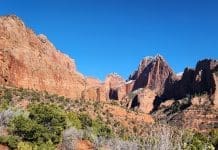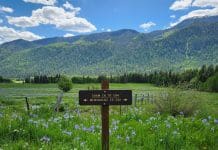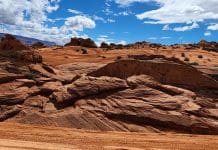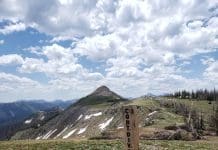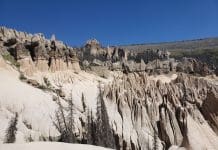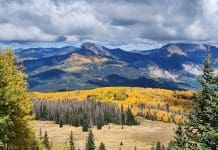In the wilderness of Carson National Forest, New Mexico, Cedar Springs Campground offers an escape for nature lovers and adventure seekers.
This hidden gem, often omitted from mainstream campsite lists, beckons those in search of unspoiled beauty and quiet solitude.
It is located in Jicarilla Ranger District of the USFS Carson National Forest.
When we were trying to find information about this campground, we really couldn’t find anything online, so decided that this post about the campground might be helpful to RV’ers and others.

Even though the Cedar Springs Campground shows up on few maps and campground directories, it is still very much an accessible campground with fabulous surroundings in the New Mexico high desert.
We camped here during the eclipse in October 2023, as we wanted to be in a remote location in the path of the eclipse. (To learn about great places to see the night skies, see our post about where to camp at the 9 Dark Sky Sanctuaries in the US.)
- Cedar Springs Campground Location
- Spectacular Scenery around the Campground
- Getting There
- Road Conditions into Cedar Springs Campground
- Driving Directions
- Campsites in Cedar Springs Campground
- A True Dispersed Camping Experience: Self-Sufficiency is Key
- Cell Service
- Area to the West of the Cedar Springs Campground
- Gas Industry in the Carson National Forest
- Notable Sites in the Area
- Conclusion
Cedar Springs Campground Location
The Cedar Springs campground is located in northwestern New Mexico in a sliver of the Carson National Forest that is in between the Jicarilla Apache Nation Reservation and Navajo Nation Land, about 45 miles to the west.
This remote campground stands as a separate entity from the primary Carson National Forest area, which extends further east within New Mexico. It is managed by the Jicarilla Ranger District.

Spectacular Scenery around the Campground
Located at an elevation of approximately 7,240 feet, this campground provides a refreshing retreat from the hustle and bustle of city life.
The scenery is a breathtaking landscape of high desert, leading into a pine forest the higher in elevation you go.

Getting There
Cedar Springs Campground is located within a remote corner of northwestern New Mexico, between the Jicarilla Apache Nation and the Navajo Nation.
Consider getting a map of the area in case you aren’t able to access information on your phone.
While the path to Cedar Springs might appear desolate, Google Maps provides accurate directions to guide you through the journey.
See the Google map below for the exact location.
Road Conditions into Cedar Springs Campground
The drive into Cedar Springs Campground in the Carson National Forest involves traveling on dirt roads.
We took a chance to drive into the area, hoping for the best with the condition of the dirt roads, as this was our first time there. We were fortunate as the roads were in good condition.
Basically any RV could make it comfortably, so long as the roads were dry. If it had rained recently, traveling might be more difficult.
To give you a sense of what the road conditions are like, below is a short video I took while driving around the area on my four wheeler.
The Jicarilla Ranger District boasts a robust, accessible, and well-maintained road network, largely a result of the extensive involvement of the oil and gas industry.
The video below is a second video I took to show the road conditions as you get closer tot he Cedar Springs campground area.
Driving Directions
We entered the area via US Highway 64, which basically cuts this sliver of Carson National Forest in half.
When you first enter the area, you will be on Jicarilla Apache Nation land. You are not allowed to camp here, so you must continue driving until you reach the National Forest.

Once you pass over a metal cattle guard in the road about 8 or so miles in, you’ll see a sign for the Carson National Forest.

From here you will transition from Jicarilla Apache Nation Land to National Forest land.

Directions within Carson National Forest
After you enter the national forest, the campground is about 5 miles away. A sign will point you in the right direction.

Continue down the dirt road, following directions from Google maps or other navigation system.
To find Cedar Springs Campground, you can use the coordinates 36.67132315146725, -107.25649528805465.
However, keep in mind that the actual turn-off into the campground is slightly further down the road than Google Maps may suggest.

As we found during our nocturnal journey, following Google’s initial turning suggestion might lead you into a rain gully.
Instead, continue driving a few hundred feet, where you’ll spot a sign on the right, directing you into the campground.

We drove in with a truck camper, pulling a large trailer. We made it just fine without any issues whatsoever.
There was a fifth wheel camped there too, so basically any RV should be able to make it just fine. There were some ruts in the ground, but they were easy to navigate.

The video below is one I took riding my four wheeler into the campground. The video shows the condition of the road into the main campground.
Campsites in Cedar Springs Campground
The campground is located at an elevation of 7,216 feet, which can translate to chilly nights, even in the warmer months.
The campground provides numerous spacious, unmarked campsites suitable for group camping.
The campsite we chose had a wide turnaround area, so it was easy to get in, unpack, turn around without backing up, etc.



Campfire rings are in each site.
Make sure you check with the Carson National Forest about whether campfires are allowed for the time of year that you visit. Wildfires are a real threat here, so you want to make sure you are not the cause of a wildfire.

The area is very quiet.
We took a hike in the back of the campground and since it was fall, the trees and bushes were beautiful.


We heard a lot of coyotes in the area, so if you have dogs, be aware and keep your dog under control at all times.

During our stay in October 2023, we noticed multiple vacant sites, despite several groups camping in the area.

It appears that hunters were most of our neighbors, as this area is popular for hunting during hunting season, so that is one consideration.
Other Group Campsites in Cedar Springs Campground
There were several other group campsites within the Cedar Springs Campground. All were suitable and accessible for RVs.

The video below shows some of the campsites from the view I took while driving around.
It shows just how big and spread out the campsites are.
A True Dispersed Camping Experience: Self-Sufficiency is Key
Cedar Springs Campground is not maintained by the US Forest Service, and its amenities are limited to none.
It used to have a vault toilet, but that has been removed.
Prepare for a true dispersed camping experience; you’ll need to bring everything required for your stay.
Should you require any supplies, the nearby town of Farmington, the most significant settlement in the area, is well-equipped with chain stores to meet your needs.
Due to the arid high desert climate, don’t forget to pack extra water to keep yourself properly hydrated.
Leave No Trace
Responsible camping is vital at Cedar Springs.
Make sure to pack out everything you bring to maintain the pristine beauty of this remote wilderness.
Dispersed Camping

In addition to the Cedar Springs Campground, there are numerous dispersed camping options throughout the Carson National Forest.
You will be able to see them along the roads, with pull offs with easy access. Most are very smooth, flat, and sandy.
Since this is USFS land, follow our guide on how to find USFS dispersed camping areas using the free online mapping resources from the USFS.



Cell Service
The campground has extremely limited cell service.
We were able to get a weak signal by climbing to a higher elevation, but don’t count on it.
If you need cell service, head west from the campground. Then turn north back towards Hwy 64 and a few miles up the road, there are a series of cell towers.
You should be able to get a strong signal along that way.
Area to the West of the Cedar Springs Campground
The video below is one I took driving west out of the Cedar Springs campground.
The road is smooth at first, as seen below, but once you head north, it becomes very rough.
We highly recommend driving into the Carson National Forest from the east.
You will need to drive through Jicarilla Apache land, but that is not an issue.
If you turn right out of the campground, you will see the sign below. Heading straight takes you to the Vigas Mesa, which has a few scenic overlooks.



We decided to take a different route home, and the road was in terrible condition.
We went west from the Cedar Springs campground, and the road was good for a few miles heading back north to Hwy 64.
Then it become incredibly rough and slow going. We were in an F-350 pickup truck, so could navigate it relatively easily, but I would not recommend it for any regular RV.
The images below are ones we took while driving this route, but it’s difficult to see how bad the roads were in these photos.



The road to the west of the campground likely sees a lot more traffic, as it is closer to Farmington, which is the biggest city in this area for miles.
Gas Industry in the Carson National Forest
As you drive through the Jicarilla Ranger District of the Carson National Forest, you will undoubtedly see many signs of the oil and gas industry in this area.

The oil industry in the Carson National Forest is a controversial and complex topic.
Located in northern New Mexico, the forest covers a vast and ecologically diverse area. While the forest itself is not a major oil-producing region, there have been discussions and debates about oil and gas extraction on the fringes of the forest.
The potential for oil extraction in the vicinity of the Carson National Forest has raised concerns about its environmental impact.
Criticisms of Oil Drilling
Critics argue that drilling and fracking operations could threaten the pristine landscapes, water sources, and wildlife habitats within the forest, as well as contribute to air and water pollution.
Proponents, on the other hand, highlight the economic benefits and job opportunities that the industry can bring to the region.
There are a lot of little side roads in the forest that end up at closed gates, most of which are part of the gas drilling industry in the Jicarilla Ranger District.


We did some exploring around the area, as there are many side roads that head toward gas rigs.
The scenery is pretty and the area is fun to explore.
The road below is a side road, and not one you need to drive on in order to access the Cedar Springs campground.
The management of oil and gas activities in and around the Carson National Forest is a subject of ongoing debate, with regulatory agencies, environmental organizations, and industry stakeholders working to balance economic interests with environmental conservation.
Conservation efforts and regulations aim to mitigate the potential negative impacts of oil and gas development on this environmentally sensitive region.
Notable Sites in the Area
Among the many interesting sites in the area, two stand out: the Gasbuggy site and the USFS Jicarilla Wild Horse Territory.
(There’s also a super funky landscape in NW New Mexico called the Bisti Badlands and De-Na-Zin Wilderness Area that is filled with hoodoos and otherworldly rock formations. It’s about 2 1/2 hours from the Cedar Springs Campground but is worth the drive since it’s so much like being on Mars.)
Gasbuggy Site

Once you enter the National Forest from the Jicarilla Apache Nation, you’ll drive about a mile and come upon an interesting location, called the Gasbuggy Interpretive site.
There’s plenty of parking there for RVs.

There are two signs there to tell you all about the significance of this site, in part, chosen for its remote location.


It may look like just a pipe sticking out of the ground, but it’s a historical site where science meets ethics.

In 1967, an experimental nuclear explosion was used 4,240 feet in the ground to fracture rock so that it would release natural gas (similar to fracking), and also to demonstrate how nuclear technology could be used for more than killing people.

While the experiment worked, it raised environmental and ethical concerns, so the program ended.
But in this part of the Carson National Forest, it appears that drilling for natural gas is still going strong. There are big gas drills about one every mile or so.
USFS Jicarilla Wild Horse Territory
Highway 64 cuts this part of the Carson National Forest in half.
The southern side is where the Cedar Springs Campground is located, but the northern side of highway 64 is also interesting as it’s a designated area for wild horses (e.g., mustangs) to roam freely.

The Jicarilla Wild Horse Territory is a sanctuary for the wild horses that roam these rugged and untamed landscapes.
This area, spanning over 76,000 acres, provides a refuge for these majestic creatures, allowing them to roam freely in their natural habitat. It is the largest and best known mustang herd ranges in northern New Mexico.
It borders the Carracas Mesa Herd Management Area maintained by the Bureau of Land Management.
The Jicarilla Wild Horse Territory is not only a testament to the rich biodiversity of the region but also a testament to the commitment to preserving the heritage and legacy of these wild horses.
Visitors to this territory can witness the beauty and resilience of these animals and gain a deeper appreciation for the delicate balance between nature and the preservation of these magnificent wild creatures.
In 1971, the Wild Free-Roaming Horses and Burros Act set aside 303 areas for these majestic creatures, and the Jicarilla Wild Horse Territory was one of them. Today, there are 186 designated wild-horse territories still in existence.
We also visited the Pryor Mountain Wild Horse Range on the border with Montana and Wyoming.
Conclusion
Cedar Springs Campground, located within the awe-inspiring Carson National Forest, offers a unique camping experience amid high desert beauty and pristine pine forests.
This remote haven is perfect for those seeking tranquility and a connection with nature.
Your journey to Cedar Springs promises stunning landscapes, adventures, and a chance to experience the unspoiled beauty of the Carson National Forest.







